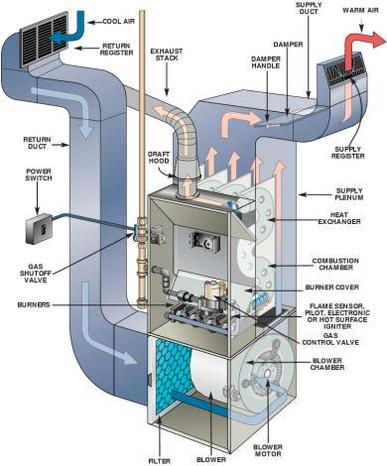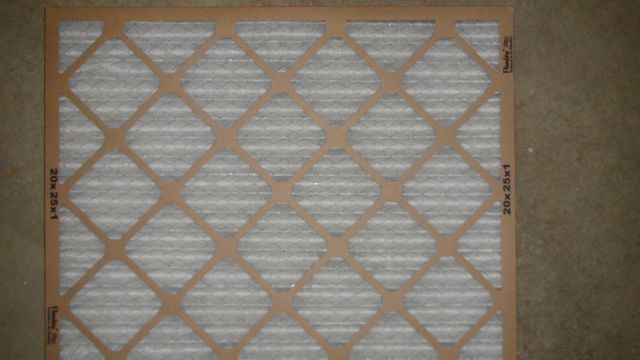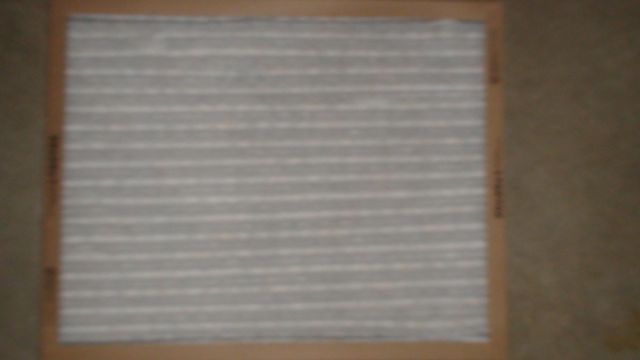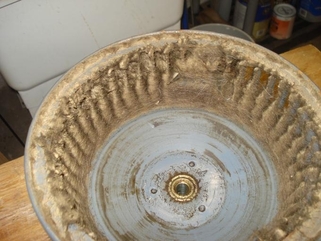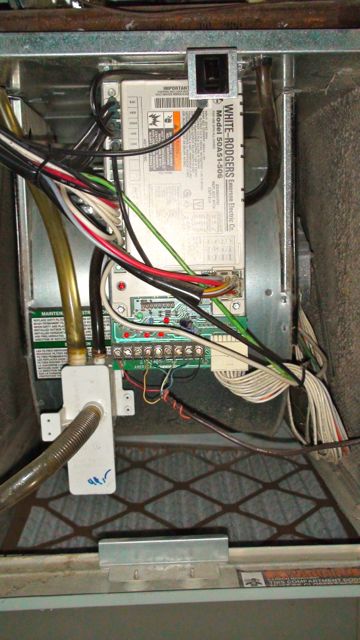- Home
- For the homeowner
- Safety
- Definitions
- Gas furnace
- Some error codes for gas furnaces
- Service sheet for the gas furnace
- gas furnace design
- The gas heat exchanger
- Dangerous conditions in gas furnaces
- Annual service of the gas furnace
- Repair procedures for gas furnaces
- Gas fireplace millivolt systems
- Oil furnace
- Setting gas input
- Quick tips for troubleshooting furnaces
- Troubleshoot
- Operation and troubleshoot furnace by manufacturer
- HVAC war stories blog
- Annual service of an oil furnace
- Oil furnace design
- Oil furnace troubleshoot
- Repair procedures for oil furnaces
- Gas code training
- Piping and connections
- FAG w pilot no fire
- Combustion analysis
- Electric furnace
- Air conditioner
- Refrigeration
- Heat Pump
- Boiler
- Ductwork design and troubleshoot
- Thermostats
- Diagnostic problems
- Tools
- Electric test meters
- Electrical diagram training
- Electrical symbols
- Single and 3 phase power systems
- Electric wiring solutions
- Transformer design and troubleshoot
- Electronic air cleaner
- Blowers and fans design & troubleshoot
- Humidity and humidifiers
- Furnace, Air Conditioner and part manuals
- Electric motors
- Run Capacitors
- Start capacitors
- Troubleshooting the capacitor
- Gas furnace short cycling
Gas, oil, electric furnace will not keep up to temperature
|
The first check with a furnace that will not keep up with the load is to check the filter.
All forced air furnaces have a filter. |
|
The filter is located in the return air.
If it is not changed or at least checked every month of the heating season, it will become plugged and will not allow sufficient air for the furnace to function.
When air flow decreases, the furnace heats up and the high temperature limit shuts off the fuel flow.
So the furnace runs until the limit shuts off the burners, then cools down and starts again.
On older furnaces, there was often no damage to the furnace due to the heavy gauge heat exchanger.
On newer furnaces, heat exchanger materials have been made thinner to increase efficiency and cannot be mistreated in this way.
Probably the best way to extend the life of a furnace is to keep the filters clean.
Symptoms of a plugged filter are low air flow from the heat registers, and a whistling sound from the furnace.
If it is not changed or at least checked every month of the heating season, it will become plugged and will not allow sufficient air for the furnace to function.
When air flow decreases, the furnace heats up and the high temperature limit shuts off the fuel flow.
So the furnace runs until the limit shuts off the burners, then cools down and starts again.
On older furnaces, there was often no damage to the furnace due to the heavy gauge heat exchanger.
On newer furnaces, heat exchanger materials have been made thinner to increase efficiency and cannot be mistreated in this way.
Probably the best way to extend the life of a furnace is to keep the filters clean.
Symptoms of a plugged filter are low air flow from the heat registers, and a whistling sound from the furnace.
|
There are many types of filters available.
The cheaper filters are made of fiberglass or polyester and are approximately 10 to 20 % efficient. These are better than nothing, but your furnace deserves better. There are many types of pleated filters on the market with higher efficiencies. These are worth considering. For the most part, the higher the price, the better the quality. You can go all the way to Hepa filters of around 95% efficiency. Note that furnace filters have an airflow arrow on them. The arrow should point toward the furnace. If you have a filter installed backwards, do no reverse it. Replace it. The filter on the right is a medium quality pleated filter. The crosshatch pattern is placed toward the furnace. As a general rule, I would say good but dont go overboard unless you have someone in the house with asthma or some other breathing problem. There are other types such as electronic and static. |
|
Low heat, filter ok
If, when the filter has been checked, it is ok, the circulating fan will have to be checked. The furnace covers will have to be removed. On an upflow furnace, the fan will be located behind the lower cover. The downflow furnace is just the opposite.
|
This is an example of a severely plugged blower. This blower wheel will move virtually no air.
You can use a vacuum cleaner and a brush with the blower installed. However, the best job can only be done with the blower removed from the furnace. On any furnace built within 35 years, the blower assembly is removed by removing 2 screws and sliding the blower out on its track. |
Blower assembly view
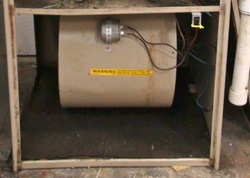
This is a blower assy as seen from the front. With the screws removed, the assembly slides out the front.
Note: The power to the furnace to the furnace will be shut off when the blower door is removed. See the switch on the upper right of the picture. You still need to be careful of electric shock as there is power behind the door switch. Turn off power at the disconnect or breaker. When the blower is removed, the wires to the blower motor must be removed. Mark them or take a pic.
Do not mix up the wires. If a blower with multiple speeds has its wires mixed up, the blower will immediately fail, accompanied by large amounts of smoke. (Electric parts run on smoke, because when the smoke comes out, they dont work anymore).
Note: The power to the furnace to the furnace will be shut off when the blower door is removed. See the switch on the upper right of the picture. You still need to be careful of electric shock as there is power behind the door switch. Turn off power at the disconnect or breaker. When the blower is removed, the wires to the blower motor must be removed. Mark them or take a pic.
Do not mix up the wires. If a blower with multiple speeds has its wires mixed up, the blower will immediately fail, accompanied by large amounts of smoke. (Electric parts run on smoke, because when the smoke comes out, they dont work anymore).
|
This is another type of furnace. The blower is behind the IFC. This must be removed. There is also a condensate drain to remove. Be careful with the condensate drain. It is plastic and some are fragile.
This must be done carefully, as there are a number of sensitive parts here. I would not remove all of the wires to the IFC. Remove the mounting screws and tie up the IFC out of the way. |
Cleaning the blower wheel.
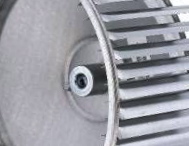
The best way to clean the blower wheel is to wash it with a strong detergent. The motor must be removed. Do not wash the blower assembly with the motor installed. Water on the motor is a recipe for disaster.
Remove the mounting wing screws, then remove the set screw on the blower wheel. Remove the motor. The motor has holes in the frame to allow air across the windings to cool it. Clean these with a toothbrush.
Remove the mounting wing screws, then remove the set screw on the blower wheel. Remove the motor. The motor has holes in the frame to allow air across the windings to cool it. Clean these with a toothbrush.
This the blower assembly
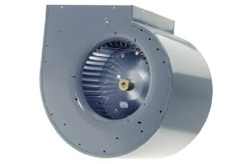
It should look like this when it is done.
When finished, the motor should be reinstalled. Slide the motor through the hub. reinstall the mounting brackets.
The blower wheel needs to be centered in the housing.
Then tighten the set screw. It must be tightened on the flat part of the shaft! The set screw should be tight.
When finished, the motor should be reinstalled. Slide the motor through the hub. reinstall the mounting brackets.
The blower wheel needs to be centered in the housing.
Then tighten the set screw. It must be tightened on the flat part of the shaft! The set screw should be tight.
The secondary heat exchanger
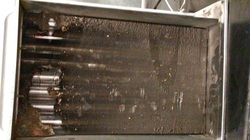
While the blower is removed, there are 2 things to be done.
If there is a secondary heat exchanger, as on a 90+ efficiency furnace, it should be checked for dirt.
The pic on left is of a partially plugged coil.
You need to look into the heat exchanger from where the fan came out. If the furnace is an 80% efficient furnace, take the opportunity to check for cracks in the heat exchanger by looking and feeling the heat exchanger tubes.
If there is a secondary heat exchanger, as on a 90+ efficiency furnace, it should be checked for dirt.
The pic on left is of a partially plugged coil.
You need to look into the heat exchanger from where the fan came out. If the furnace is an 80% efficient furnace, take the opportunity to check for cracks in the heat exchanger by looking and feeling the heat exchanger tubes.
Air conditioning coil
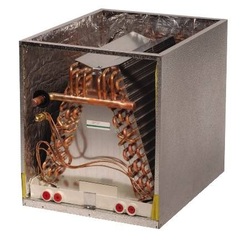
If your furnace has an air conditioning coil, it should be mounted on top of the furnace.
This coil, like the secondary heat exchanger, is easily plugged.
Removal of this part is sometimes a larger project.
If it can be lifted up a couple inches, you can inspect it.
This coil, like the secondary heat exchanger, is easily plugged.
Removal of this part is sometimes a larger project.
If it can be lifted up a couple inches, you can inspect it.
The video below illustrates how an air conditioning coil can get blocked. This video will be available 4-15-2015
If the blower is not running at all, there could be a motor problem. If the motor is not turning at all, and the motor is hot, the bearings may have seized due to lack of lubrication. The video below shows how to lubricate the bearings. Understand, if the bearings have seized, the bearings may have been damaged. You may get the motor running but it will probably fail soon.
Cycling problems
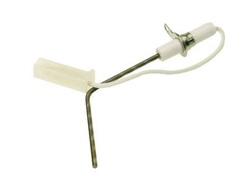
If the furnace is not running all the time the thermostat is calling for heat, it will not keep up with the load. On newer furnaces, if the flame is not sensed, the furnace will think the flame is not on and shut off the burners. On the left, is a sensor that extends into the burner flame to sense the flame. See sequencing This is a stainless steel rod and it becomes dirty from from chemicals in the air supplied for combustion.
It can be cleaned with steel wool or sandpaper. Sometimes this will solve the problem because if it does not sense flame well it will occasionally shut down the furnace. This may cause you a very frustrating time. The furnace will usually try to restart after it has shut down for 1 hour. The end result will be a furnace not working sometimes and when you move the thermostat up and down it starts running again. Newer furnaces are somewhat like computers in that if rebooted (shut off then restarted) they will begin operating again.
To see if this the problem, raise the temperature setting on the thermostat well above the structure temperature. Watch the furnace operate. It should run continuously with the flame and the circulating fan.
It can be cleaned with steel wool or sandpaper. Sometimes this will solve the problem because if it does not sense flame well it will occasionally shut down the furnace. This may cause you a very frustrating time. The furnace will usually try to restart after it has shut down for 1 hour. The end result will be a furnace not working sometimes and when you move the thermostat up and down it starts running again. Newer furnaces are somewhat like computers in that if rebooted (shut off then restarted) they will begin operating again.
To see if this the problem, raise the temperature setting on the thermostat well above the structure temperature. Watch the furnace operate. It should run continuously with the flame and the circulating fan.
Thermostat short cycling mechanical thermostats only.
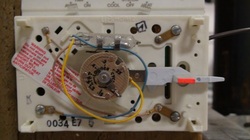
Short cycling of a furnace will cause it to not keep up with the load. Mechanical thermostats are not capable of sensing temperature changes closer than 4 degrees. 2 degrees above and 2 degrees below the temperature.
Most people can sense a 3 degree difference in temperature. In order to overcome this problem, a small heater is included in the thermostat. The heater is placed close to the bimetal (left center dial). When the thermostat is calling for heat, power passes through the heater warming the bimetal which warps the bimetal opening the thermostat circuit earlier than it normally would to account for the extra time the furnace runs after the thermostat shuts off thus "anticipating" the heating needs of the structure. It keeps the temperature as close as 1/2 degree +or-.
The heater or "anticipator" is adjustable to the control circuit current. If the anticipator is adjusted too high, it provides too much heat and turns off the furnace too early. Then it comes back on again too early. This is called "short cycling". The dial of the anticipator has numbers on it and an arrow that points to "longer". If the furnace is short cycling, set the anticipator to longer about 1/4 inch. If that does not appear to be enough, set it 1/4 inch more.
If the furnace runs too long, the anticipator is set too long and needs to be set back.
If you have a clamp on ammeter, you can set the anticipator to the amperage draw of the control circuit. If your thermostat is electronic, the anticipation is built in to the hardware.
Most people can sense a 3 degree difference in temperature. In order to overcome this problem, a small heater is included in the thermostat. The heater is placed close to the bimetal (left center dial). When the thermostat is calling for heat, power passes through the heater warming the bimetal which warps the bimetal opening the thermostat circuit earlier than it normally would to account for the extra time the furnace runs after the thermostat shuts off thus "anticipating" the heating needs of the structure. It keeps the temperature as close as 1/2 degree +or-.
The heater or "anticipator" is adjustable to the control circuit current. If the anticipator is adjusted too high, it provides too much heat and turns off the furnace too early. Then it comes back on again too early. This is called "short cycling". The dial of the anticipator has numbers on it and an arrow that points to "longer". If the furnace is short cycling, set the anticipator to longer about 1/4 inch. If that does not appear to be enough, set it 1/4 inch more.
If the furnace runs too long, the anticipator is set too long and needs to be set back.
If you have a clamp on ammeter, you can set the anticipator to the amperage draw of the control circuit. If your thermostat is electronic, the anticipation is built in to the hardware.
Capacity problems
At this point, we have eliminated air flow blockages or cycling and will need to look for capacity problems.
A gas input check should be made. This is explained on this page.
If the gas input is ok continue.
It is possible the furnace is too small. I would caution that this is not often the case. This problem should only show up during very cold temperatures, or if the home has had additions made with no additions in furnace capacity.
If the furnace has been heating normally in the past, look for something that has happened recently.
Ductwork problems could be the cause. Check all heat registers for air flow when the furnace is on. They should all be the same. If one or more of them are low on air flow compared to the others, inspection of the ductwork is necessary.
Ductwork can be located in a basement, a crawl space or in the attic. Look for pipes that are not connected. In mobile homes that are double wide, the furnace is mounted on one side of the home. When the home is installed, there is a crossover pipe that is run across from one side to the other. This pipe is usually a flexible insulated pipe and may have pulled off or been crushed by animals. The symptom of this problem is low air flow on one side of the home.
Also, uninsulated runs of pipe can lose heat if they are exposed to the cold outside air.
A gas input check should be made. This is explained on this page.
If the gas input is ok continue.
It is possible the furnace is too small. I would caution that this is not often the case. This problem should only show up during very cold temperatures, or if the home has had additions made with no additions in furnace capacity.
If the furnace has been heating normally in the past, look for something that has happened recently.
Ductwork problems could be the cause. Check all heat registers for air flow when the furnace is on. They should all be the same. If one or more of them are low on air flow compared to the others, inspection of the ductwork is necessary.
Ductwork can be located in a basement, a crawl space or in the attic. Look for pipes that are not connected. In mobile homes that are double wide, the furnace is mounted on one side of the home. When the home is installed, there is a crossover pipe that is run across from one side to the other. This pipe is usually a flexible insulated pipe and may have pulled off or been crushed by animals. The symptom of this problem is low air flow on one side of the home.
Also, uninsulated runs of pipe can lose heat if they are exposed to the cold outside air.
If the gas input is not high enough
This could have several causes. One, it may not have been set properly at installation. Again, I would caution that if the furnace has been working normally in the past, and suddenly the gas input is not enough, that indicates a possible supply problem (gas utility) or a failure on the gas regulator in the gas valve. You should not attempt to adjust gas line pressure from the meter as this the job of the utility.
If the gas input is very low (1/2 of the name plate rating), the unit may be a 2 stage furnace and only one stage is operating. If the thermostat has been recently replaced, it may not have been wired properly.
If the gas input is very low (1/2 of the name plate rating), the unit may be a 2 stage furnace and only one stage is operating. If the thermostat has been recently replaced, it may not have been wired properly.
2 stage furnace
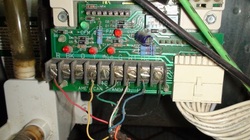
Note on this pic the terminal board.
The terminal "W1" is hooked to the white wire.
The terminal "W2" is hooked to the blue wire.
This unit is wired for 2 stage operation. If you clock the meter with only one stage on, the gas input will be 1/2.
If there is a jumper between W1 and W2, the unit will start on 1/2 gas input, then wait 10 minutes and then go to full firing rate. If you are checking the firing rate of this type of furnace, you must remember that the furnace will not come up to full firing rate for the 10 minutes. (this is the sequence for Trane furnaces. The sequence will be somewhat different for other brands).
The point is, you must check this and understand. Back to troubleshoot
The terminal "W1" is hooked to the white wire.
The terminal "W2" is hooked to the blue wire.
This unit is wired for 2 stage operation. If you clock the meter with only one stage on, the gas input will be 1/2.
If there is a jumper between W1 and W2, the unit will start on 1/2 gas input, then wait 10 minutes and then go to full firing rate. If you are checking the firing rate of this type of furnace, you must remember that the furnace will not come up to full firing rate for the 10 minutes. (this is the sequence for Trane furnaces. The sequence will be somewhat different for other brands).
The point is, you must check this and understand. Back to troubleshoot
